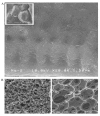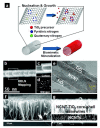Environmental Remediation Applications of Carbon Nanotubes and Graphene Oxide: Adsorption and Catalysis
- PMID: 30875970
- PMCID: PMC6474092
- DOI: 10.3390/nano9030439
Environmental Remediation Applications of Carbon Nanotubes and Graphene Oxide: Adsorption and Catalysis
Abstract
Environmental issues such as the wastewater have influenced each aspect of our lives. Coupling the existing remediation solutions with exploring new functional carbon nanomaterials (e.g., carbon nanotubes, graphene oxide, graphene) by various perspectives shall open up a new venue to understand the environmental issues, phenomenon and find out the ways to get along with the nature. This review makes an attempt to provide an overview of potential environmental remediation solutions to the diverse challenges happening by using low-dimensional carbon nanomaterials and their composites as adsorbents, catalysts or catalysts support towards for the social sustainability.
Keywords: adsorption; carbon nanomaterials; carbon nanotubes; catalysis; environmental remediation; graphene; graphene oxide.
Conflict of interest statement
The authors declare no conflict of interest. The founding sponsors had no role in the design of the study; in the collection, analyses, or interpretation of data; in the writing of the manuscript, and in the decision to publish the results.
Figures











Similar articles
-
Sustainable nanotechnology based wastewater treatment strategies: achievements, challenges and future perspectives.Chemosphere. 2022 Feb;288(Pt 3):132606. doi: 10.1016/j.chemosphere.2021.132606. Epub 2021 Oct 19. Chemosphere. 2022. PMID: 34678350 Review.
-
Mitigation of environmentally-related hazardous pollutants from water matrices using nanostructured materials - A review.Chemosphere. 2020 Aug;253:126770. doi: 10.1016/j.chemosphere.2020.126770. Epub 2020 Apr 12. Chemosphere. 2020. PMID: 32464768 Review.
-
Carbon Nanomaterials for the Treatment of Heavy Metal-Contaminated Water and Environmental Remediation.Nanoscale Res Lett. 2019 Nov 11;14(1):341. doi: 10.1186/s11671-019-3167-8. Nanoscale Res Lett. 2019. PMID: 31712991 Free PMC article. Review.
-
Adsorptive removal of lead (II) ion from water and wastewater media using carbon-based nanomaterials as unique sorbents: A review.J Environ Manage. 2020 Jan 15;254:109814. doi: 10.1016/j.jenvman.2019.109814. Epub 2019 Nov 11. J Environ Manage. 2020. PMID: 31726282 Review.
-
Developments in the Application of Nanomaterials for Water Treatment and Their Impact on the Environment.Nanomaterials (Basel). 2020 Sep 7;10(9):1764. doi: 10.3390/nano10091764. Nanomaterials (Basel). 2020. PMID: 32906594 Free PMC article. Review.
Cited by
-
Carbon-based sustainable nanomaterials for water treatment: State-of-art and future perspectives.Chemosphere. 2021 Jan;263:128005. doi: 10.1016/j.chemosphere.2020.128005. Epub 2020 Aug 19. Chemosphere. 2021. PMID: 33297038 Free PMC article. Review.
-
Graphene Oxide (GO) Materials-Applications and Toxicity on Living Organisms and Environment.J Funct Biomater. 2022 Jun 10;13(2):77. doi: 10.3390/jfb13020077. J Funct Biomater. 2022. PMID: 35735932 Free PMC article. Review.
-
Control of pH-Responsiveness in Graphene Oxide Grafted with Poly-DEAEMA via Tailored Functionalization.Nanomaterials (Basel). 2020 Mar 27;10(4):614. doi: 10.3390/nano10040614. Nanomaterials (Basel). 2020. PMID: 32230739 Free PMC article.
-
Covalent Organic Framework Composites: Synthesis and Analytical Applications.Molecules. 2020 Nov 18;25(22):5404. doi: 10.3390/molecules25225404. Molecules. 2020. PMID: 33218211 Free PMC article. Review.
-
Application of Graphene and Carbon Nanotubes on Carbon Felt Electrodes for the Electro-Fenton System.Materials (Basel). 2019 May 25;12(10):1698. doi: 10.3390/ma12101698. Materials (Basel). 2019. PMID: 31130594 Free PMC article.
References
-
- Werber J.R., Osuji C.O., Elimelech M. Materials for next-generation desalination and water purification membranes. Nat. Rev. Mater. 2016;1:16018. doi: 10.1038/natrevmats.2016.18. - DOI
-
- Nakayama M., Kabayama S., Ito S. The hydrogen molecule as antioxidant therapy: Clinical application in hemodialysis and perspectives. Ren. Replace. Ther. 2016:2. doi: 10.1186/s41100-016-0036-0. - DOI
Publication types
Grants and funding
LinkOut - more resources
Full Text Sources

